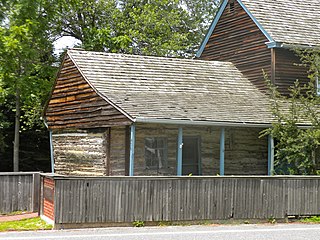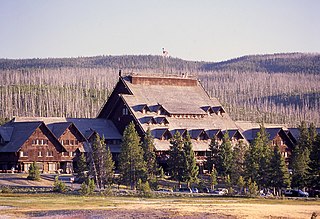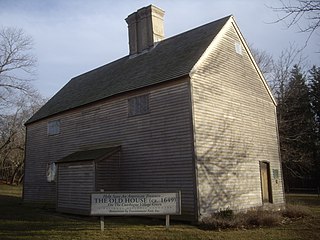
Gibbstown is an unincorporated community and census-designated place (CDP) located within Greenwich Township, in Gloucester County, in the U.S. state of New Jersey. As of the 2010 U.S. census, the CDP's population was 3,739. Gibbstown is the location of C. A. Nothnagle Log House, purportedly the oldest house in New Jersey and the oldest surviving log house in the U.S., dating to around 1638.

Greenwich Township is a township in Gloucester County, in the U.S. state of New Jersey. As of the 2020 United States census, the township's population was 4,917, an increase of 18 (+0.4%) from the 2010 census count of 4,899, which in turn reflected an increase of 20 (+0.4%) from the 4,879 counted in the 2000 census.

Swedesboro is a borough within Gloucester County in the U.S. state of New Jersey, within the Philadelphia metropolitan area. As of the 2020 United States census, the borough's population was 2,711, its highest decennial count ever and an increase of 127 (+4.9%) from the 2,584 recorded at the 2010 census, which in turn had reflected an increase of 529 (+25.7%) from the 2,055 counted at the 2000 census. Swedesboro and surrounding Gloucester County constitute part of South Jersey.

The Old Faithful Inn is a hotel in the western United States with a view of the Old Faithful Geyser, located in Yellowstone National Park, Wyoming. The Inn has a multi-story log lobby, flanked by long frame wings containing guest rooms. In the western portion of the park, it sits at an approximate elevation of 7,350 feet (2,240 m) above sea level.

A log cabin is a small log house, especially a less finished or less architecturally sophisticated structure. Log cabins have an ancient history in Europe, and in America are often associated with first-generation home building by settlers.

The Dewitt Log Homestead is a historic building near Oxford, Ohio, listed in the National Register on 1973-04-13.

The Old House is a historic home on State Route 25 in Cutchogue in Suffolk County, New York. It is "notable as one of the most distinguished surviving examples of English domestic architecture in America."

The Old Faithful Historic District in Yellowstone National Park comprises the built-up portion of the Upper Geyser Basin surrounding the Old Faithful Inn and Old Faithful Geyser. It includes the Old Faithful Inn, designed by Robert Reamer and is itself a National Historic Landmark, the upper and lower Hamilton's Stores, the Old Faithful Lodge, designed by Gilbert Stanley Underwood, the Old Faithful Snow Lodge, and a variety of supporting buildings. The Old Faithful Historic District itself lies on the 140-mile Grand Loop Road Historic District.

The Buckner Homestead Historic District, near Stehekin, Washington in Lake Chelan National Recreation Area incorporates a group of structures relating to the theme of early settlement in the Lake Chelan area. Representing a time period of over six decades, from 1889 to the 1950s, the district comprises 15 buildings, landscape structures and ruins, and over 50 acres (200,000 m2) of land planted in orchard and criss-crossed by hand-dug irrigation ditches. The oldest building on the farm is a cabin built in 1889. The Buckner family bought the farm in 1910 and remained there until 1970, when the property was sold to the National Park Service. The Buckner Cabin was listed on the National Register of Historic Places in 1974. The rest of the Buckner farm became a historic district in 1989. Today, the National Park Service maintains the Buckner homestead and farm as an interpretive center to give visitors a glimpse at pioneer farm life in the Stehekin Valley.

The Col. James Graham House is a historic log cabin located on West Virginia Route 3 in Lowell, West Virginia. It was built in 1770 as a home for Col. James Graham, the first settler of Lowell, and his family. It was later the site of an Indian attack on the Graham family in 1777. The house was added to the National Register of Historic Places on March 16, 1976. The Graham House is the oldest multi-story log cabin in West Virginia. It is currently operating as a museum.

Trinity Church, also known as Old Swedes' Church, is a historic church on the northwest corner of Church Street and King's Highway in Swedesboro in Gloucester County, New Jersey, U.S.

The Covington House historic cabin in Vancouver, Washington, was built by Richard and Charlotte "Anna" Covington born, raised and married in London, England who travelled by ship around Cape Horn/South America, stopping at the Sandwich Islands/Hawaii and finally arriving at Fort Vancouver in the Oregon Territory, where they had been hired to teach children of the Hudson's Bay Company employees. The first three "plains" of the area were held by Hudson Bay Fur Trade Co. whereas the fourth "plain" was opened up for public sale as property north of the Columbia River became part of the United States, the government gave newly acquired land to early pioneers, willing to settle and farm the land. The Covingtons taught at the Fort immediately after their arrival, 1846 until 11 April 1848 when they entered "donation land claim" No. 43 640 acres (2.6 km2) in the Fourth Plain area, the community now referred to as Orchards, Wa, where they built their home, House No. 16 and Boarding School, per the 1850 census. Although they never had any of their own children, the couple established a boarding school in addition to operating a large fruit farm, called the Kalsus Farm. The children slept in the cabin loft, as it was an arduous seven – eight-mile trek, one way, north east of the Fort and wrought with danger for small children to attempt to travel alone. The Covington's log cabin soon became known as the social center of hospitality with musical entertainment in the early days of Vancouver on the Columbia River. Besides his guitar, they also brought a violin and the first piano to the Pacific Northwest as well, they also taught music to many of these local children at that time. Richard Covington was extremely talented, in addition to building their log cabin home, and developing an expansive orchard, he served in several offices as a justice of the peace, county clerk, school superintendent, cartographer, artist, musician, vocalist, and briefly as a ranger during an "Indian uprising" First Nations/Native Americans.

The Log Cabin at present-day 1805 Hancock Street in Bellevue, Nebraska was built in the 1830s, and is commonly acknowledged as the oldest building in Nebraska.

The Lower Swedish Cabin is a historic Swedish-style log cabin which is located on Creek Road in the Drexel Hill section of Upper Darby, Pennsylvania, along Darby Creek. The cabin may be one of the oldest log cabins in the United States and is one of the last cabins built by the Swedish settlers that remains intact.

The Wonderland Trail is an approximately 93-mile (150 km) hiking trail that circumnavigates Mount Rainier in Mount Rainier National Park, Washington, United States. The trail goes over many ridges of Mount Rainier for a cumulative 22,000 feet (6,700 m) of elevation gain. The trail was built in 1915.
Midgaard, also known as the Lautner Cottage, is a chalet style log cabin located on Middle Island Point, near Marquette, Michigan. It is significant as the first building that then-12-year-old John Lautner helped construct. Midgaard was listed on the National Register of Historic Places in 2013.
The New Sweden Farmstead Museum was an open-air museum in Bridgeton, New Jersey, United States. A recreation of a 17th-century Swedish farmstead, it was located in City Park, and served as a historical remembrance of the history of the Swedish and Finnish people who arrived as part of the colony of New Sweden in early America. Originally opened in 1988, it operated as a living museum for many years. As funding and attendance declined, the log buildings at the complex fell into disrepair, requiring it to close.
The Harold–Knoernschild Farmstead Historic District, also known as Centennial Farms, is a historic home and farm and national historic district located at Augusta, St. Charles County, Missouri. The house was built about 1836, and is a two-story, log farmhouse sheathed in weatherboard. A one-story brick addition was constructed about 1882. The house features a stone chimney with hearths on both stories and a two-story, full facade porch. Also on the property is a contributing board-and-batten barn dated to about 1860 and two early-20th century farm outbuildings. The house was built by Leonard Harold, founder of Augusta.

Mortonson–Van Leer Log Cabin, also known as Schorn Log Cabin, is a historic cabin and one of the last historical dwellings in Swedesboro, New Jersey, United States. It stands on the grounds of the cemetery of the Trinity Church. It is one of the oldest original log cabins of early Swedish-Finnish architecture in the United States.

The Pap Madison Cabin is a historic log cabin located in Rapid City, South Dakota, near The Journey Museum and Learning Center. It is the oldest Euro-American building in the Black Hills area. The cabin was built in 1876 by pioneer Rufus 'Pap' Madison using cottonwood found alongside the banks of the nearby Rapid Creek. Madison stayed in the house from its completion until 1889, when he sold the land to Rapid City's founder, John Brennan. Brennan gave the cottage to the city in 1926.


















